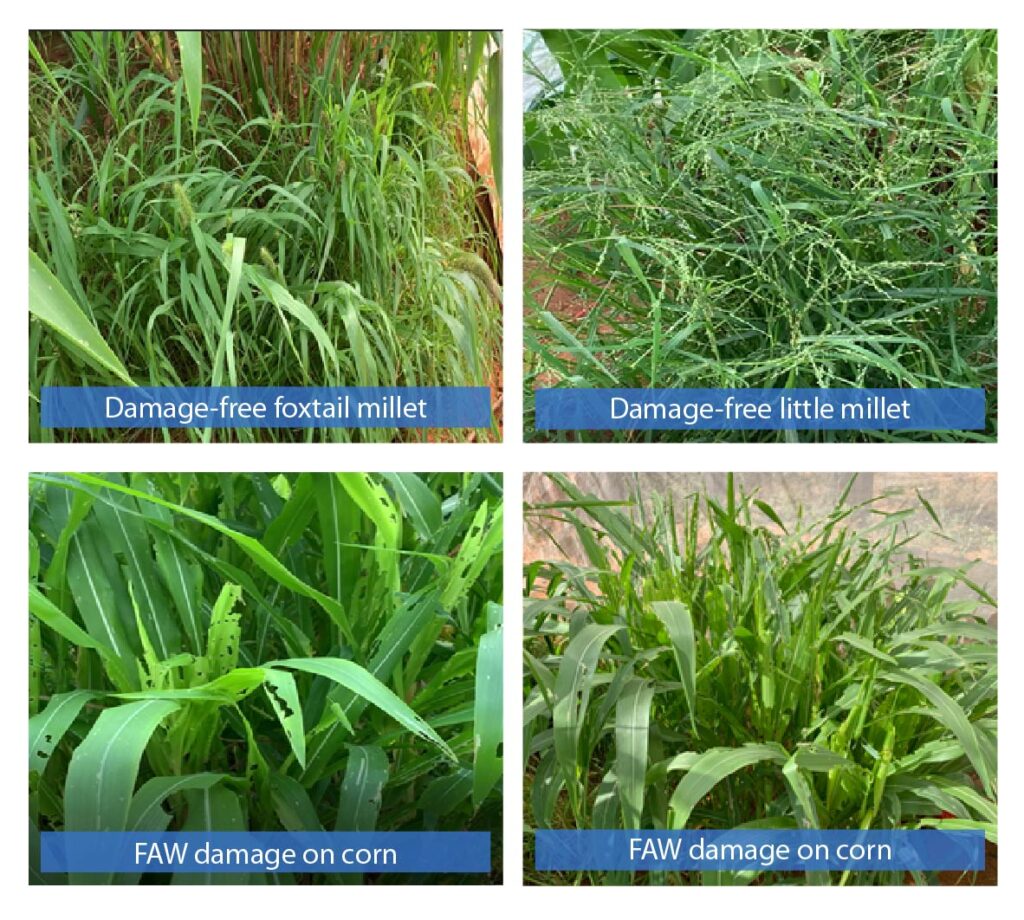Millets cultivation limits fall armyworm population growth


“Now that health and wellness have become a preferred lifestyle, nutrition-oriented food items are gaining in popularity. Millets, one of the oldest crops known to humans, can grow in adverse weather conditions with minimal irrigation. Millets are nutritionally healthy, climate-resilient, drought and heat-tolerant, and can be grown even in poor soil conditions. Based on a proposal from the Government of India, the United Nation General Assembly declared 2023 The International Year of Millets.
However, millets are prone to attack by various biotic stresses such as fall armyworm (FAW), which can be a potential threat to millets cultivation. FAW is a voracious feeder and has been reported to feed on more than 350 plant species. Though the relative preference exhibited by FAW for different crops has not yet been reported, corn shown the highest preference for feeding by FAW. Researchers at Hytech Seeds India Ltd, initiated studies to demonstrate relative preference for colonization of corn over millets by FAW when grown together in nylon net enclosures.
In the first trial, two corn hybrids with two pearl millets hybrids were compared. The hybrids were sown inside a nylon net enclosure (5 meters long; 3 meters wide and 3 meters high) in the field at Ravalkol research station of Hytech, in randomized block design with four replications. Since FAW infestations are erratic under natural conditions, natural conditions were simulated by releasing laboratory-reared FAW adults on all plants. In nature however, host plant selection is done by FAW adults and the population of FAW builds up from there to inflict leaf-feeding damage on the plants.
In view of the above, the hybrids were artificially infested with laboratory-reared one-day-old FAW adults (100 males and 100 females). Observations showed that the two corn hybrids suffered significantly greater leaf-feeding damage by FAW larvae than on millet hybrids (Photo 1). Although equal numbers of FAW eggs were deposited on corn and millets, the larval establishment and damage on millets remained drastically low. These results suggest that FAW adults would be attracted to millets, but their progenies on millets will remain very small compared to corn. The newly emerged FAW larvae failed to feed on millets and left the crop in sheer desperation and frustration. The population dynamics of FAW were affected negatively on millets, leading to very small populations of FAW; thus, bringing about a substantial control of FAW without application of toxic chemicals for FAW management.
These results were further confirmed in another trial conducted at the Hytech research station at Ravalkol. Three proprietary corn hybrids were planted along with six millet cultivars: barnyard millet, finger millet, foxtail millet, little millet, kodo millet, and mr1-finger millets, in the field in a completely randomized block design with two replications. The plants were enclosed inside the nylon net cage and infested with 70 males and 70 females of FAW to initiate FAW infestations on the plants, as explained above.
The results showed that FAW preferred corn greater than millets (Photo 3 and 4). Leaf-feeding damage caused by FAW on millet cultivars was significantly reduced compared to corn hybrids. Among the millet cultivars, kodo, little millet, and foxtail millets suffered lesser damage than barnyard, finger millets, and MR1. Unlike pearl millet hybrids, FAW did not prefer certain millets, such as foxtail millets, for its population establishment and reproduction. This shows that FAW cannot colonize the millets to inflict damage thereon, and the cultivation of different types of millets will benefit the overall health of the environment because very little insecticide spray would be needed to protect the plants from pest attack.
In fact, millets have evolved to survive in extremely harsh conditions without any need for human intervention, and the present work shows that hardly any intervention would be needed to control even the most dreaded pests like FAW. Through reduced dependence on fertilizer and pesticides, millet cultivation will help to promote a shift toward sustainable agriculture. Millet cultivation will also be useful in intercropping with pest-susceptible crops such as corn, because millets may attract the ovipositing pest population without supporting the growth and development of the damaging stages of the pest as explained above. In this way, the pest is diverted away from the most preferred host (corn), thereby reducing crop losses.
Economically, replacing high-value crops with low-value millet cultivation cannot be justified by the farmer, but millets can be promoted through fallow crops or intercrops to help regenerate the health of the soil, environment, and a guarantee for farmers’ livelihood. In this way, millets fit perfectly for regenerative farming in India.
The cultivation of millets will help to achieve Sustainable Development Goals (SDG) primarily related to zero hunger (SDG2); good health and wellness (SDG3); sustainable production and consumption (SDG12); and climate action (SDG13)”
Author – Harish Kumar, PhD, Entomologist, Hytech Seeds India, Ltd

Source – communications@smsfoundation.org